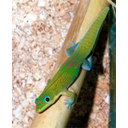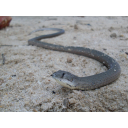Gekkota
Gekkota - geckoes and pygopodids
| Lepidosauria; Squamata; Gekkota |
The Gekkota
is a monophyletic clade containing the familiar geckoes, as well as the pygopodids - a group of limbless
lizards commonly referred to as Australasian
legless lizards. To learn more about their place in squamate phylogeny, please return to the Squamata main page.
Diversity and Lower Taxonomy
Traditionally (e.g. Estes et al. 1988), the geckoes and pygopodids
have been divided into two distinct families, as follows:
- Family Gekkonidae (geckoes)
- comprising approximately 1180 species of gecko divided between
five subfamilies.
- Subfamily Gekkoninae -
containing 75 genera.
- Subfamily Teratoscincinae -
containing a single genus, Teratoscincus.
- Subfamily Diplodactylinae -
containing 18 genera.
- Subfamily Eublepharinae -
containing 5 genera.
- Subfamily Aeluroscalabotinae -
containing one genus, Aeluroscalabotes.
- Subfamily Gekkoninae -
containing 75 genera.
- Family Pygopodidae - 39
species of pygopodid divided between seven genera in two subfamilies.
- Subfamily Pygopodinae -
conatining 23 species divided between 3 genera.
- Subfamily Lialisinae -
containing 16 species in 4 genera.
- Subfamily Pygopodinae -
conatining 23 species divided between 3 genera.
This
Gekkonidae-Pygopodidae dichotomy proposed the monophyly of the two groups,
and Gekkota was therefore defined as encompassing the last common ancestor of
these two families, plus all its descendents. Both morphological (e.g. Kluge
1987) and molecular (e.g. Saint et al. 1998) phylogenetic studies
have, however, demonstrated that Pygopodidae is nested within Gekkonidae, more
closely related to the diplodactylines (subfamily Diplodactylinae) than to
other gekkotans. Under these conditions, the term Gekkonidae becomes
phylogenetically redundant, as if Pygopodidae is excluded from its definition,
then Gekkonidae is paraphyletic, and if Pygopodidae
is included, then Gekkonidae becomes equivalent to the higher Gekkota
(including geckoes and pygopodids).
Nonetheless,
Gekkotan interrelationships are by no means fully resolved, and not all
researchers agree with a nested position for Pygopodidae. More recently, a
molecular study conducted by Jonniaux & Kumazawa (2008) proposed that the
subfamilies Eublepharinae and Aeluroscalabotinae form a distinct
family, Eublepharidae, that is siter to Gekonidae (containing the three
remaining traditional gekkonid genera), and in turn this clade is sister to Pygopodidae. This
molecular-based grouping is interesting as it corroborates certain morphological
differences between these groups (see Descriptions section below).
Description
It is
useful to describe the appearance and morphology of geckoes and pygopodids
separately, as they are clearly distinct. Bear in mind, however, that it is
possible that the pygopodids evolved within the geckoes. If this is the case,
then pygopodids are in fact geckoes themselves, and may have secondarily lost
many gekkotan features in favour of specialisation for a burrowing mode of
life. Consequently, the term 'gecko' below refers to an informal (i.e., not
phylogenetic) grouping meaning 'any non-pygopodid gekkotan'.
Geckoes are a familiar group of often
strikingly coloured small to average-sized lizards, ranging from 30 mm (Sphaerodactylus ariasae) to 350 mm (e.g. Rhacodactylus leachianus, Gekko gecko), with a tail that is
similar in length to the snout-vent
length (s-v; distance
between the snout and the cloacal opening, or vent, at the base of
the tail). Most are nocturnal (these species have vertically slitted pupils),
but some genera are diurnal (with rounded pupils, e.g. Phelsuma), and a few even show both
diurnal and nocturnal activity. The majority are insectivorous, but some will
eat small reptiles, and some larger species have been known to consume small
rodents. They are oviparous, with the exception of members of the
following three live-bearing genera: Hoplodactylus, Naultinus and Rhacodactylus.
Geckoes can
be divided into two main forms: those with moveable eyelids (the eublepharines & aeleuroscalabotines,
corresponding to the potential family Eublepharidae, as above), and those
with fixed eyelids (the
gekkonines, teratoscincines, and diplodactylines, corresponding to the
remaining members of the traditional family Gekkonidae). Within the latter
grouping, there is a further division based on the presence (arboreal species)
or absence (usually terrestrial species) of adhesive toe pads - a specialisation for arboreal locomotion.
These pads consist of a set of overlapping expanded scales on the base of the
toes, possessing millions of microscopic hair-like protrusions (called setae),
each of which branches into hundreds of 200 nm wide tips (called spatulae).
This microstructure acts as an extremely strong adhesive (each hair can resist
200 µN of force), allowing these geckoes to walk up smooth vertical surfaces,
and even upsidedown. In fact, these hairs are so sticky that a gecko can hang
from a ceiling by just a single toepad, and a single hair (seta) could lift an
ant!
Pygopodids are a small group of average
sized (7-25 cm s-v) limbless lizards, feeding mainly on insects and some
lizards. They are slender and elongate, with no traces of pectoral skeleton. The pelvic girdle is, however,
still present in part, and the hindlimbs persist as vestigial scaly flaps. The
majority of pygopodids are diurnal, but Paradelma orientalis, as well as subsepecies of Pygopus nigriceps are nocturnal.
Like most geckoes, they are oviparous.
Distribution and Habitat
Geckoes are distributed worldwide, and
are most speciose in the tropics, subtropics, and deserts. They are either
terrestrial or arboreal.
Pygopodids are found in
Conservation Status (IUCN)
Geckoes - Of the 91 species of gecko
listed in the IUCN Red List, the majority (52 species) have been assessed as Least Concern (LC). Two species (Lepidoblepharis montecanoensis and Phelsuma antanosy) are Critically Endangered (CR), while four
are Endangered (EN), ten are Vulnerable (VU), and eleven are Near Threatened (NT). The remainder (10
species) are Data Deficient (DD).
Pygopodids - the conservation status
of seven pygopodid species has been assessed by the IUCN. All but one are Vulnerable (VU), and the other is Near Threatened (NT).
Synapomorphies of the Gekkota
Licensed under the Creative Commons Attribution Non-commercial Share Alike 3.0 License
'Vertebrate Diversity' has been released as an open educational resource (OER) on a Creative Commons 'Attribution Non-commercial Share Alike' license. This means that once downloaded, content can be modified and improved to complement a particular course. This requires, however, that improvements are recycled back into the OER community. All content present at the time of download must be accordingly credited and, in turn, novel content must be appropriately licensed. For more information, please refer to the license deed by clicking on the link above.

